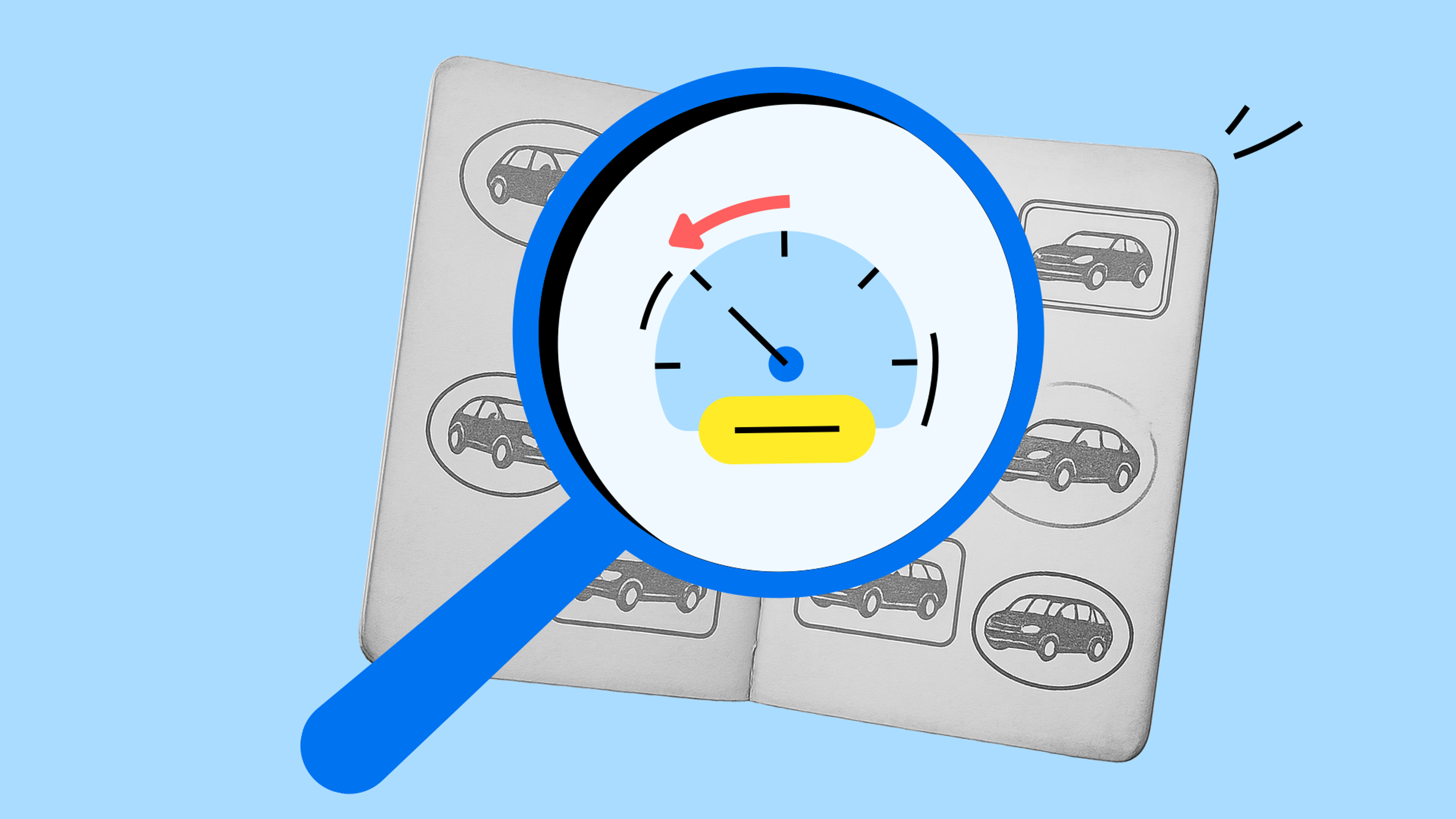08/10/2025
Research: Is buying older cars riskier due to clocking and damages?

Age may be just a number, but in the used car market it can reveal more than you think. Sure, older cars are the usual suspects – sellers often get “creative” with the mileage or gloss over past accidents to bump up the price of a well-worn ride.
But here’s the twist: even newer cars can hide their share of skeletons. Low mileage and a shiny exterior don’t guarantee a spotless history. Some 3- or 5-year-old models already come with clocked odometers or damage records that sellers would rather keep under wraps.
To uncover the scale of the problem, we analyzed millions of carVertical history reports across 16 European countries, revealing just how age influences the risks lurking behind a used car.
Research findings
- Vehicles manufactured in 2005 are the riskiest for clocking, with 8.8% of models showing manipulated mileage.
- Newer cars are clocked less often (1.6% of 2020 models and 1.5% of 2022 models), but mileage fraud still exists even in relatively young vehicles.
- Latvia leads the clocking statistics with 10.9% of cars affected, while Ukraine (9.8%), Lithuania (7.3%), and Romania (7.1%) also show high prevalence.
- Nearly half (48.9%) of all checked vehicles have damage records, with cars made between 2008 and 2016 having the highest probability of past accidents (over 50%).
- Newer cars also get damaged, and their repairs cost more – for example, average repair costs grew from €2,000 for 2000 models to €4,458 for 2020 models.
- Poland has the largest share of damaged vehicles (62.6%), followed by Slovakia (61.8%).
- The oldest vehicles (20+ years) typically show fewer damage records, likely due to older registration practices.
- Cars with an average age of 10.9 years are the most common among buyers, with 2019 models leading (7.7% of all checked vehicles).
- Across Europe, the age of checked cars varies from 8.8 years in Croatia to 13.2 years in Finland.
Clocking is more prevalent in older cars
The study revealed that vehicles manufactured in 2005 have the highest chances of being clocked – 8.8% models had mileage discrepancies. In fact, some older vehicles have their odometers tampered with more than once, which is why buyers need to stay extra cautious when shopping for a used vehicle.Other risky years include 2003 (8.7%), 2006 (8.6%), and 2007 (8.6%). The temptation to believe a “too good to be true” odometer reading is strong, but let’s be real: if a car creeping up on its 20th birthday claims only 150,000 km, it should raise an eyebrow or two. Most cars – diesel especially – rack up closer to 20,000 km a year. Do the math.
Now, newer cars are clocked less often, but as our research shows, the problem hasn’t vanished. For instance, 1.6% of cars manufactured in 2020 had manipulated mileage, along with 1.5% of 2022 models. Small numbers, yes – but still not zero.
And here’s the catch: newer cars are more expensive to buy, maintain, and repair. So if you end up with a 3-year-old car that’s been clocked, you’re not only overpaying at the start but also risking a hefty repair bill when worn-out parts start to show their true age.
Looking across Europe, Latvia takes the lead in mileage rollbacks, with 10.9% of cars showing signs of tampering – on average, by a whopping 103,824 km. The riskiest year? 2008, where nearly 1 in 5 cars (19.8%) had rolled-back mileage. Other hotspots include Ukraine (9.8%), Lithuania (7.3%), and Romania (7.1%), proving that clocking is especially prevalent in Eastern and South-Eastern Europe.
All told, the cars in our study had an average rollback of 89,295 km. Put another way: imagine spotting a car listing with 180,000 km on the odometer. Sounds decent? Well, the reality might be closer to 270,000 km. And once a car edges toward 300,000 km, critical components could be due for replacement – leaving that “budget-friendly” buy feeling a lot less like a bargain.
Every second car has damage records, with newer vehicles also showing significant share of accident history
According to our research, nearly half of all checked vehicles (48.9%) have damage records. Cars manufactured between 2008 and 2016 are the most accident-prone, with more than half showing a history of bumps, scrapes, or worse.
But don’t be fooled into thinking newer cars are spotless. 5-year-old vehicles aren’t exactly angels either – 38.1% of them had recorded damage. In other words, 4 out of 10 “fresh-looking” rides may be hiding some not-so-pretty secrets.
And when newer cars do get damaged, the repair bills tend to sting a lot more. Thanks to pricey parts and cutting-edge tech, costs keep climbing: while fixing a 2000 model averaged €2,000, repairs for 2015 models rose to €3,930, and for 2020 models hit €4,458.
Looking at Europe, Poland tops the charts with the highest share of damaged vehicles (62.6%), with 2015 models standing out (66.9%). Slovakia isn’t far behind, with 61.8% of checked cars carrying a damage history.
Interestingly, the oldest vehicles (20+ years) tend to have fewer recorded damages. Odd? Not really. This is likely down to old-school paperwork – back then, many records were logged in physical documents rather than digital databases, leaving gaps in today’s online history reports.
Cars with an average age of 10.9 years are the most common among buyers
Unsurprisingly, drivers tend to chase newer rides. Cars made in 2019 are the most popular among buyers, making up 7.7% of all vehicles checked on carVertical last year. They’re followed closely by 2018 models at 7.5% and 2017 models at 7.1% – proof that many shoppers prefer cars that still feel modern but come with a friendlier price tag than brand-new ones.
Overall, the average age of cars checked on carVertical in 2024 was 10.9 years – a drop from 11.7 years in 2023. In other words, buyers are leaning toward slightly newer vehicles. But, as always, the picture changes depending on where you look.
In Finland and Lithuania, drivers checked some of the oldest cars in our study, averaging 13.2 and 12.5 years, respectively. Meanwhile, buyers in Croatia (8.8 years), Slovakia (9 years), and Italy (9.3 years) are keeping an eye on much fresher rides.
Avoiding clocked and damaged cars with carVertical
Getting a vehicle history report is one of the smartest ways to steer clear of cars with hidden damages or suspicious mileage rollbacks. A carVertical report gives you the full story – from odometer readings and accident history to title records, ownership changes, and more.
All you need is the car’s VIN code. You’ll usually find it on the dashboard (visible through the windshield on the driver’s side), on the driver’s side door jamb, or in the vehicle’s paperwork. Pop it into our VIN decoder, and within minutes you’ll have a detailed report at your fingertips.
This kind of check can reveal problems that even the sharpest eye might miss during a physical inspection – saving you from a financial headache later on. After all, while a dented bumper or a few scratches won’t ruin your ride, a car that’s been through a major accident is a different story. In those cases, it’s crucial to carefully assess the condition, since some vehicles may pose risks not just to you, but to everyone else on the road.
Methodology
To show the correlation between the age of the car and the rate of clocking and accident history, we analyzed carVertical vehicle history reports generated by our users in 16 European countries in 2024 – Czechia, Croatia, France, Hungary, Slovakia, Italy, Latvia, Lithuania, Poland, United Kingdom, Romania, Serbia, Ukraine, Belgium, Germany, and Finland.
The data used in this research allows us to prove the hypothesis of potentially higher risks when buying older cars.
